Do-it-yourself oven for a garage: a review of the 4 best home-made designs
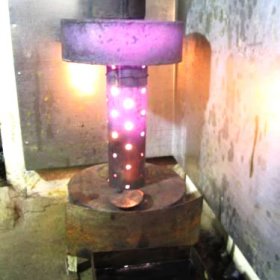
Unfortunately many motorists, the central heating for garageslocated far from home, technology is not provided. In the cold season, the temperature in the room becomes, to put it mildly, not comfortable, and in severe frosts - simply unbearable. Standard electric heater practically can not cope with the problem: electricity bills are growing, and the amount of heat remains almost unchanged. The way out of the situation is to make a furnace for the garage with your own hands.
The garage is a specific place. This is a room with limited space, in which the car owner sometimes spends a lot of time. Therefore, the device requirements for a garage stove are such requirements:
- compact sizes;
- the possibility of using solid or liquid fuel;
- ability to warm up quickly;
- ability to maintain high temperature indoors for a long time;
- simple construction;
- relatively low price of materials;
- convenience in operation and maintenance.
A check for compliance with these requirements can withstand a small furnace made of refractory bricks, some varieties of bourgeois, as well as units that use waste materials.
When planning to make a stove in a garage with your own hands, do not forget about security issues. Heating equipment should not significantly reduce the amount of oxygen in the room and emit hazardous substances when heated. In addition, the possibility of ignition of materials surrounding the stove should be prevented.
Content
Option # 1 - reliable and efficient brick
Brick stoves in garages are not common, because the option is quite time-consuming. Such a device occupies a small area of approximately 2X2.5 bricks. For masonry, a refractory brick is taken, and a solution of sand, refractory clay and fireclay powder is kneaded.

In the manufacture of a brick oven for a garage, special fireclay bricks are used, and during the mixing of the mortar it is recommended to add fireclay powder
For the combustion chamber, fireclay bricks are used at the level of the second, third and fourth rows of masonry. The height of such a brick kiln is usually equal to nine bricks. To remove the furnace gases, a brick chimney is arranged in which a stainless steel sleeve is inserted. A chimney is removed, usually through the roof.
Novice builders who decide to build a brick stove in the garage should discuss the nuances of the project with an experienced stove maker - because this is a whole science worthy of a separate profession. If significant flaws are allowed during operation, the masonry will have to be destroyed and completely redone.
Brick stoves are widely used not only for heating the garage, but also to provide heat to homes. You can add them yourself.Our site provides detailed instructions and articles on this topic. For example, this one:https://aquatech.tomathouse.com/en/otoplenie/kirpichnye-pechi-svoimi-rukami-sekrety-remesla.html.
Option # 2 - a homemade potbelly stove
Making the oven with your own hands for the garage is the easiest way from metal, that is, making an ordinary potbelly stove. To do this, use sheet metal, a metal pipe or a barrel. It is easier to make an aggregate of a cubic shape out of a metal sheet, and, of course, a cylindrical potbelly stove will be obtained from a pipe or barrel. The thickness of the metal in any case should be at least 5 mm. A metal pipe suitable for the manufacture of a potbelly stove should be wide enough, not less than 300 mm in diameter.
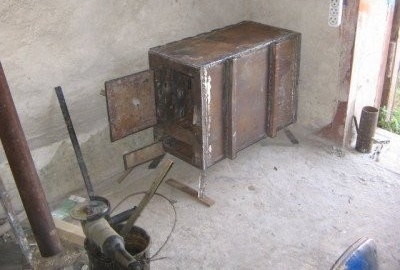
To make a do-it-yourself stove for a garage, you will need sheet metal or a suitable metal container in size, as well as a corner, pipes and other materials
The chimney outlet is preferable to arrange from the top, but sometimes it is more convenient to do it from the back wall. In the latter case, care must be taken to ensure that the chimney slope is at least 30 degrees. For efficient exhaust gas removal, it is preferable to use a metal pipe with a diameter of 120 mm or more. In the first meters, the chimney should be quite thick - 2-3 mm. Thinner material with constant heating will quickly burn out.
Directly under the firebox, a place should be arranged for ash removal. To do this, use a horizontal metal plate with slots. The dimensions of the slots depend on the size of the potbelly stove and the type of fuel. For a small stove working on coal and small wood, the size of the slots should be 10-12 mm, and for a large wood-burning stove, cuts of at least 40 mm should be made.
A removable box is installed under the partition, which is periodically cleaned as ash accumulates. For the drawer, three millimeter sheet steel is used. To increase the efficiency of the potbelly stove, metal plates 5 mm thick are welded perpendicularly to its sides. Thus, the area of contact of air with the heating unit increases and the room heats up faster.
You will find detailed installation instructions for the stove-pot for the summer house and garage in our next article:https://aquatech.tomathouse.com/en/otoplenie/bani-i-garazh/pechka-burzhujka-svoimi-rukami.html.
When cutting sheet metal, the thickness of the material itself, as well as the thickness of the disc of the grinder, should be taken into account. An interesting option for the manufacture of potbelly stoves from gas cylinders is presented in the video material:
Option # 3 - a waste oil stove
Firewood and coal are not available everywhere, but every motorist has a certain amount of used engine oil. Therefore, the unit in which such oil is used is very popular. Although its design is somewhat more complicated than that of a potbelly stove, you can easily make such a stove for a garage with your own hands.

The furnace for working out for the garage consists of two departments, in the first of which the used oil is burned, and the second is intended for burning of the formed gases mixed with air
The developmental furnace is an H-shaped device consisting of:
- fuel tank;
- afterburners;
- temperature chamber;
- chimney.
Vapors generated during the combustion of the main fuel enter the next chamber and mix in it with air. Here, additional combustion occurs at a very high temperature, which ensures high efficiency of the device.
A furnace is made in waste oil from sheet metal. For the lower tank, you can use a finished metal box to which you should weld the legs. It is necessary to make a hole in it with a metal shutter. Fuel is supplied to it, and the supply of primary air is controlled by a damper.
The upper chamber has a cylindrical shape. It is connected to the tank with a metal pipe, in which holes with a diameter of 10 mm are made for the intake of secondary air.The chimney in such a stove should be installed exclusively from above.
In such an oven, you can use a variety of types of mining: solar oil, gear oil, petroleum, transformer, as well as kerosene, diesel fuel, fuel oil, etc. However, the use of flammable substances such as acetone, gasoline or solvents is unacceptable, although a small amount of gasoline can use when firing the oven.
More details about this version of the furnace we have written in the article: Do-it-yourself stove stove for a summer house and a garage - instructions for self-manufacturing
Option # 4 - long burning wood stove
The peculiarity of the long-burning furnace is that it does not need to put firewood in it for 10-15 or even 20 hours. This result is achieved using full fuel loading and a special shutter. The thrust in the stove becomes moderate, after which the wood does not burn, but rather smolder slowly. The combustion rate is regulated by air.
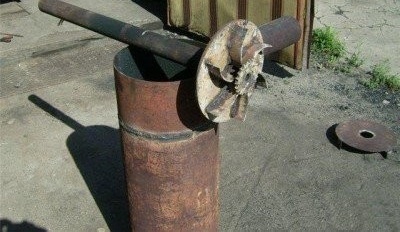
In a long-burning furnace, firewood does not burn, but smolder, which allows heating the garage for 10-20 hours without adding firewood to the furnace
For the manufacture of a long-burning furnace, it is recommended to use a ready-made metal barrel with a volume of 200 liters. The upper part of the barrel is cut off and a hole is made in it under the chimney pipe. In addition, a hole should be made for a 100 mm pipe through which air will flow. In order to ensure efficient draft and complete removal of fuel combustion products, the diameter of the chimney of a long-burning furnace should be at least 150 mm.
Read more about the chimney for such a stove in the article: How to make a chimney for a stove: the simplest chimney in steps
Then make the goods. This is a circle cut out of sheet metal, to which a pair of pieces of a channel are welded. The dimensions of the circle should allow it to move freely inside the barrel. Then cut a hole to which a piece of a 100 mm pipe is welded. As an alternative to a barrel, you can use a fairly long section of a large diameter metal pipe. To make the bottom, not a round, but a square piece of metal can be welded to the edge of the pipe to make the structure more stable.
The load is inserted into the barrel, and on top of it is covered. In this case, the air supply pipe is inserted into the hole cut out for it. It remains to cut two hatches: for feeding firewood into the oven and for removing ash. Hatches are closed with metal covers. The finished long-burning furnace is usually installed on a special brick foundation.
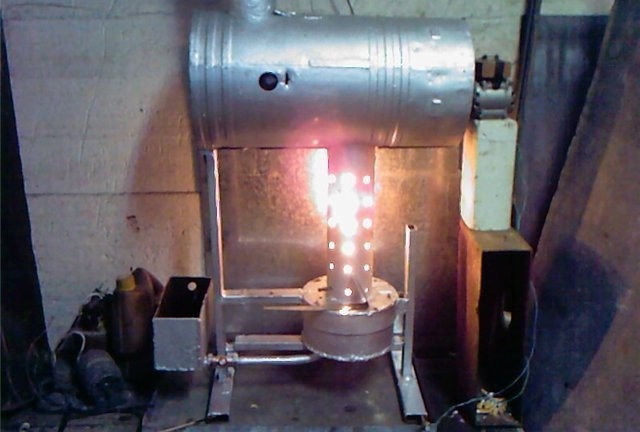
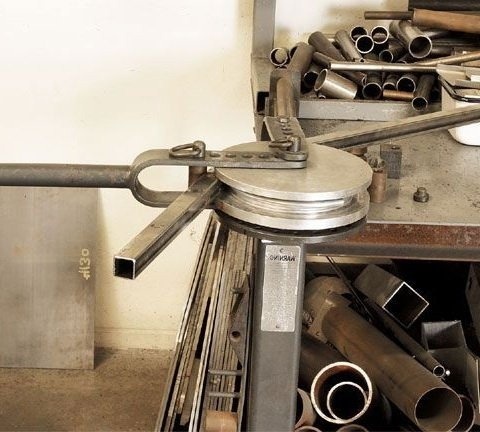
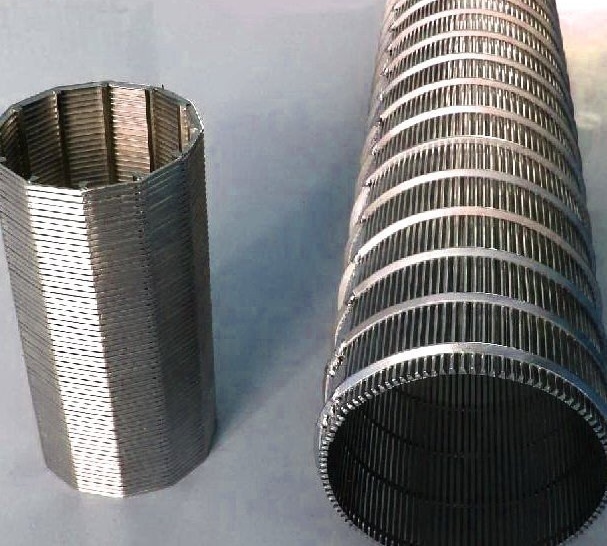
3 comments